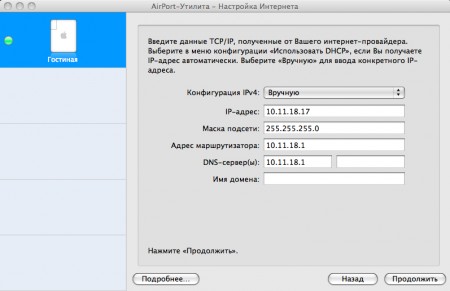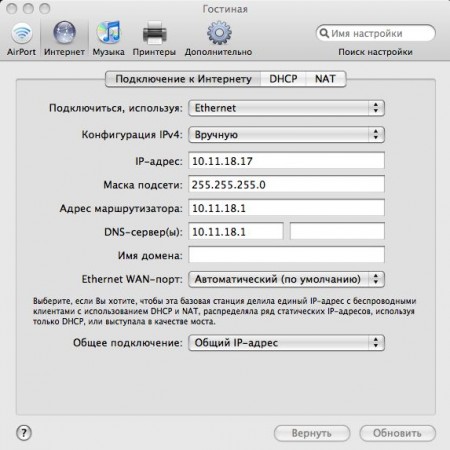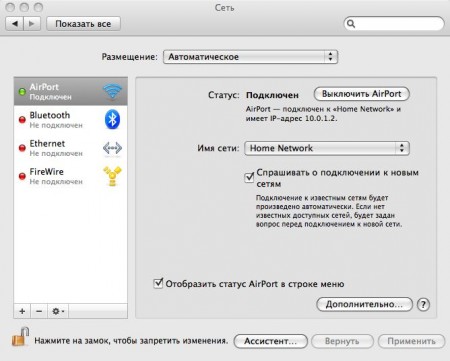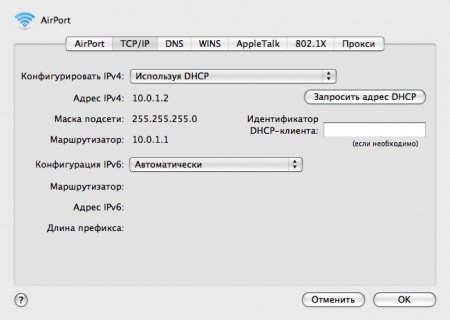How did I get onto Mack. Part 2. Me, Mac, Internet
This is a continuation of the article , which many, judging by the comments, wanted to hear. The continuation is very funny, and even comical in places, directly related to the Internet settings. I'm not at all sure that this is exactly what you would like to hear. The article is likely to be interesting only to novice Mac users. Nevertheless, I’ll write about setting up the Internet, in particular the wi-fi wireless point, and about the difficulties that arose because “in Macs it’s not as bad as some people think about it” © dinamyte dinamyte.
So, I came home, and the first thing I decided to set up the network, because the Internet is our everything. Everything is very simple here, only if you know exactly what needs to be done. This is what I will try to tell.
Knowing what a MAC address is will help you avoid many Internet problems and silly things, such as:
As I already learned after the fact, after reading in one article, “most home and city networks use access via DHCP, with the internal IP address associated with the MAC address of the network card. Which in itself is neither good nor bad - because in most cases the user does not care: when changing the machine (and network card) it’s enough to call the provider for re-binding. ” I am now so smart, and then a lot of difficulties arose.
At first I tried to configure the Internet myself, I spent about an hour and a half, thinking up how this can be done and studying the settings. I really did not want to bother anyone, but I had to, and as it turned out not in vain - I myself would not have solved the problem with the Internet. It was possible to find out what and how to do it only as a result of a conference consisting of two people from a store in Kiev, where I took a computer, and several administrators of my network. So, the recipe is how to do it right.
To begin with, it’s worth saying that to my MacBook I bought a wi-fi point AirPort Express. I can not give reasoned enough reason why it is her, and not some other point. I followed the principle that in any case, the Mac Wi-Fi point should be friends with the MacBook, if not better, then certainly not worse than the same third-party devices. Before that, I had no business with wi-fi points, so I had to figure everything out in the course of the play :)
The principle of connecting via a wi-fi point on the Macs is implemented approximately as follows: the Internet goes to the point, and then it is sent to the computer. Therefore, you need to configure it accordingly: first you need to configure the wi-fi point. To do this, go to Finder> Programs / Applications> Utilities and select Air Port Utility / Air Port Utility. First, you need to connect the Air Port base station itself to the network and plug an Ethernet cable into it, as it was in my case. If a wi-fi point is connected, it appears in the list on the left, as shown in the screenshot.

Now we will create a network. Click Continue> Create a New Wireless Network> Enter the name of the wireless network and the name of the base station (any one of your choice)> Select the security level and enter the wireless password. It should be said here that it is better to use WPA 2 as a more reliable one (as I was advised, and I pass on the advice of specialists to you). > We choose how to connect to the Internet. For me, this is the first proposed option> Enter the TCP / IP data received from the provider, the password to protect the base station and click Create.

If you later need to view or change your Air Port settings, this is done in this way. Go back to Finder> Programs / Applications> Utilities and select Air Port Utility / Air Port Utility. Double-clicking on the image of the base station, we get into its settings. Go to the Internet tab, where you can check or change the entered settings (connection method, IP address, subnet mask, address of the router and DNS server). In my standard settings specified in the contract, there was no router, and it turned out that it corresponds to a DNS server. As you can see, you can still connect a sound system to the Air Port, to which music from iTunes will be transferred, or a printer to make it network. We don’t need all this yet, we set up the wi-fi point, move on.

Hooray, the network is created, go to step 2. Now you need to connect the computer to the wi-fi point. Here, as it turned out, there is no need to philosophize slyly. Go to the system settings. There are two ways to do this: either by clicking on the corresponding icon in the dock, or by clicking on the apple on the top panel and choosing System Preferences. Select the menu item Network. This window opens here:

Select the Advanced tab - and cheers! Hurrah! - we get into the network settings. Go to the TCP / IP tab> Select Using DHCP and click on request DHCP address. In this case, the computer connects to the wi-fi point, and that already gives him the IP address. Congratulations, now everything should work!

It remains only to call back the network administrators, and ask them to use the MAC address of the base station as the main one, because we will access the Internet in this way. It can be found either on the box or on the device itself. It is necessary to specify the Air Port ID, and not the Ethernet ID (as I was told).
This is such a difficult way to establish a wi-fi connection on a Mac. The main difficulty here is to know where the settings are located, because it is a little difficult for a person who has migrated to Windows to find them in different places.
During one of the visits to configure the wi-fi point, the manager and I went through the settings again and made sure that everything was right there. Then he advised me to call the provider - if it doesn’t work at all, let them come and configure manually. Ok, I'm calling. I tell you that in addition to the laptop, I also bought a wi-fi point, that I need to configure it. I say I have a Mac. The admin says, “Please wait,” picks up the phone away and begins to retell the situation to colleagues. Then there is a pause, and then for a minute only laughter excitedly is heard. I did not understand what it was. Either the harsh Linuxoids decided - that's it, it came to us, or the situation reminded them of some famous quote from Bash, which I don’t know about ... Yes, I look - we love makovodov :)))
Nothing, the one who laughs last laughs well :) I was soon able to verify this. For two weeks the Internet worked for me in the “I want to work, I want to not” mode, periodically flying out at the most inopportune moment. At first there was some kind of breakdown, then the equipment was changed, then something else. And now the day before the last exam, the Internet again goes into oblivion and is not going to appear. I’m just ashamed to call my provider again, but I have to bother him again - the Internet is desperately needed, another half of the questions need to be learned, a textbook on the Internet.
When attempts to reanimate my Internet connection came to nothing, an administrator went to visit me to configure it on the spot. Then I saw what happens if a person who has never sat on a Mac tries to do something on it for the first time. I am sure the admin decided that the Mac is the most terrible, uncomfortable and incomprehensible computer. To begin with, the Start button is not there - oh, horror! Conclusion: in case something goes wrong, you need to know where the Air Port utility, network utility, terminal and console are located on the Mac (look for Finder> Applications / Utilities> Utilities) and System Settings.
We sat for a very long time figuring out what happened. All settings are entered correctly, the light on the Air Port is green, which means that it sees the network, but it does not respond and there is no connection. Everything turned out to be very simple - I don’t know how it happened there, maybe as a result of rebooting something, their MAC address changed in the system. When you entered the correct one, everything worked again. Therefore, once again I remind you of the importance of the MAC address, and if this happens, now you will know what to do.
I apologize again for the “multibuccoff”, but I really hope that this article will help you save your time if you encounter the same difficulties. If there are any corrections, clarifications, tips, I am waiting for comments.
UPD: Something strange happened to the comments. You need to scroll down a bit to see comments in normal encoding. Thank you all for reading :)
UPD1: Comments corrected! Only now, instead of the letter Ш, they remained !!! :)
So, I came home, and the first thing I decided to set up the network, because the Internet is our everything. Everything is very simple here, only if you know exactly what needs to be done. This is what I will try to tell.
ABOUT THE IMPORTANCE OF MAC ADDRESS
Knowing what a MAC address is will help you avoid many Internet problems and silly things, such as:
After numerous unsuccessful attempts to set up the Internet itself, I still call the provider, explain the situation:
Hello! So and so, I bought a laptop, I'm trying to get online from it, all the settings are correct, but nothing works.
“Of course, nothing will work, because you have a new MAC address.”
For me, the term MAC address itself did not say anything at that time, I still thought: “How do they know that I have a Mac”? (verily - blonde :)))
As I already learned after the fact, after reading in one article, “most home and city networks use access via DHCP, with the internal IP address associated with the MAC address of the network card. Which in itself is neither good nor bad - because in most cases the user does not care: when changing the machine (and network card) it’s enough to call the provider for re-binding. ” I am now so smart, and then a lot of difficulties arose.
At first I tried to configure the Internet myself, I spent about an hour and a half, thinking up how this can be done and studying the settings. I really did not want to bother anyone, but I had to, and as it turned out not in vain - I myself would not have solved the problem with the Internet. It was possible to find out what and how to do it only as a result of a conference consisting of two people from a store in Kiev, where I took a computer, and several administrators of my network. So, the recipe is how to do it right.
CONFIGURE WIFI POINT
To begin with, it’s worth saying that to my MacBook I bought a wi-fi point AirPort Express. I can not give reasoned enough reason why it is her, and not some other point. I followed the principle that in any case, the Mac Wi-Fi point should be friends with the MacBook, if not better, then certainly not worse than the same third-party devices. Before that, I had no business with wi-fi points, so I had to figure everything out in the course of the play :)
The principle of connecting via a wi-fi point on the Macs is implemented approximately as follows: the Internet goes to the point, and then it is sent to the computer. Therefore, you need to configure it accordingly: first you need to configure the wi-fi point. To do this, go to Finder> Programs / Applications> Utilities and select Air Port Utility / Air Port Utility. First, you need to connect the Air Port base station itself to the network and plug an Ethernet cable into it, as it was in my case. If a wi-fi point is connected, it appears in the list on the left, as shown in the screenshot.

Now we will create a network. Click Continue> Create a New Wireless Network> Enter the name of the wireless network and the name of the base station (any one of your choice)> Select the security level and enter the wireless password. It should be said here that it is better to use WPA 2 as a more reliable one (as I was advised, and I pass on the advice of specialists to you). > We choose how to connect to the Internet. For me, this is the first proposed option> Enter the TCP / IP data received from the provider, the password to protect the base station and click Create.

If you later need to view or change your Air Port settings, this is done in this way. Go back to Finder> Programs / Applications> Utilities and select Air Port Utility / Air Port Utility. Double-clicking on the image of the base station, we get into its settings. Go to the Internet tab, where you can check or change the entered settings (connection method, IP address, subnet mask, address of the router and DNS server). In my standard settings specified in the contract, there was no router, and it turned out that it corresponds to a DNS server. As you can see, you can still connect a sound system to the Air Port, to which music from iTunes will be transferred, or a printer to make it network. We don’t need all this yet, we set up the wi-fi point, move on.

SETTING UP THE INTERNET ON A COMPUTER
Hooray, the network is created, go to step 2. Now you need to connect the computer to the wi-fi point. Here, as it turned out, there is no need to philosophize slyly. Go to the system settings. There are two ways to do this: either by clicking on the corresponding icon in the dock, or by clicking on the apple on the top panel and choosing System Preferences. Select the menu item Network. This window opens here:

Select the Advanced tab - and cheers! Hurrah! - we get into the network settings. Go to the TCP / IP tab> Select Using DHCP and click on request DHCP address. In this case, the computer connects to the wi-fi point, and that already gives him the IP address. Congratulations, now everything should work!

It remains only to call back the network administrators, and ask them to use the MAC address of the base station as the main one, because we will access the Internet in this way. It can be found either on the box or on the device itself. It is necessary to specify the Air Port ID, and not the Ethernet ID (as I was told).
This is such a difficult way to establish a wi-fi connection on a Mac. The main difficulty here is to know where the settings are located, because it is a little difficult for a person who has migrated to Windows to find them in different places.
ONCE AGAIN ABOUT THE IMPORTANCE OF MAC ADDRESS
During one of the visits to configure the wi-fi point, the manager and I went through the settings again and made sure that everything was right there. Then he advised me to call the provider - if it doesn’t work at all, let them come and configure manually. Ok, I'm calling. I tell you that in addition to the laptop, I also bought a wi-fi point, that I need to configure it. I say I have a Mac. The admin says, “Please wait,” picks up the phone away and begins to retell the situation to colleagues. Then there is a pause, and then for a minute only laughter excitedly is heard. I did not understand what it was. Either the harsh Linuxoids decided - that's it, it came to us, or the situation reminded them of some famous quote from Bash, which I don’t know about ... Yes, I look - we love makovodov :)))
Nothing, the one who laughs last laughs well :) I was soon able to verify this. For two weeks the Internet worked for me in the “I want to work, I want to not” mode, periodically flying out at the most inopportune moment. At first there was some kind of breakdown, then the equipment was changed, then something else. And now the day before the last exam, the Internet again goes into oblivion and is not going to appear. I’m just ashamed to call my provider again, but I have to bother him again - the Internet is desperately needed, another half of the questions need to be learned, a textbook on the Internet.
When attempts to reanimate my Internet connection came to nothing, an administrator went to visit me to configure it on the spot. Then I saw what happens if a person who has never sat on a Mac tries to do something on it for the first time. I am sure the admin decided that the Mac is the most terrible, uncomfortable and incomprehensible computer. To begin with, the Start button is not there - oh, horror! Conclusion: in case something goes wrong, you need to know where the Air Port utility, network utility, terminal and console are located on the Mac (look for Finder> Applications / Utilities> Utilities) and System Settings.
We sat for a very long time figuring out what happened. All settings are entered correctly, the light on the Air Port is green, which means that it sees the network, but it does not respond and there is no connection. Everything turned out to be very simple - I don’t know how it happened there, maybe as a result of rebooting something, their MAC address changed in the system. When you entered the correct one, everything worked again. Therefore, once again I remind you of the importance of the MAC address, and if this happens, now you will know what to do.
I apologize again for the “multibuccoff”, but I really hope that this article will help you save your time if you encounter the same difficulties. If there are any corrections, clarifications, tips, I am waiting for comments.
UPD: Something strange happened to the comments. You need to scroll down a bit to see comments in normal encoding. Thank you all for reading :)
UPD1: Comments corrected! Only now, instead of the letter Ш, they remained !!! :)
